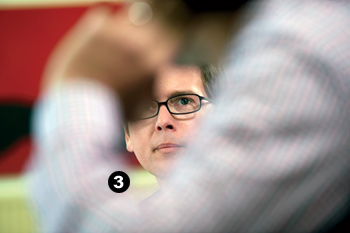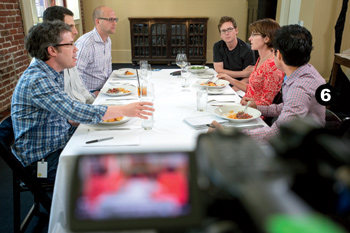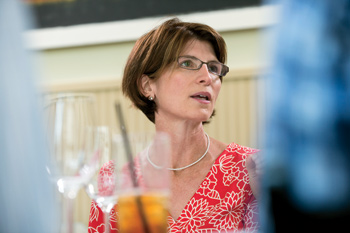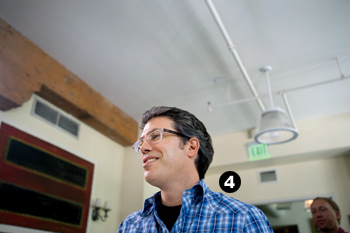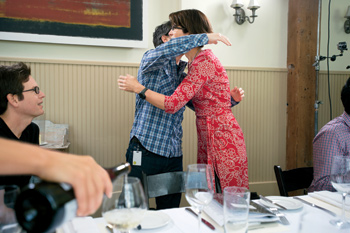Farhad Manjoo: What have you learned about the ways social media can make a difference in activism--and where it fails?
Hunter Walk: It is one of the really important fundamental changes in how companies like ours approach goodness. We are not going to pick an issue, write checks, have our CEO appear at a nice dinner.We get behind the principle that when people can connect and interact with one another, they do good things together.
Meg Garlinghouse: During the last year, we've seen people using LinkedIn to find a specific skilled relief worker to fly to Haiti, and the same thing with the Japanese earthquake.
Biz Stone: And a lot of it overlaps. A lot of the stuff that our business unit is working on for small businesses is for social good, too.
Walk: We just added auto-correct for videos, image stabilization, audio normalization. Those features benefit a guy taping a buddy skateboarding in the park and a human-rights activist with a phone. I didn't have to create a "YouTube for Activists."
Manjoo: Ken, Zynga is a little bit different from other companies here. You create an item in a game that people buy, and proceeds go to charity. It's something you set up, not your users, right?
Ken Weber: Haiti and Japan proved the model for us. We knew that our players wanted to do something within the games, and our employees responded. In the first 24 hours, we generated $1 million, and it got up to more than $3 million over a week or so. We had people paying for items in the games, but we also had players who don't ever pay for anything who got their credit cards out to do something good.
Stone: That speaks to one of my fantasies, which is that philanthropy is the future of marketing. People who normally hadn't given you their credit-card information were now doing it. You have their information, and they might become a paying customer. If people take their marketing budgets and try to use them for good, you'll end up with something more.
Manjoo: One of the criticisms about activism on social networks is that people are only loosely tied to a given cause. You turn your avatar green--but then that's all you do. Is that fair?
Garlinghouse: Slacktivism.
Weber: If somebody gives, we ask, Have you given to this charity before? Do you intend to give to this charity again? And by a ratio of like 100 to 1, people were also going outside of the game to, for example, Water.org.
Nick Grudin: We also see cases where organizations are putting social networking at the heart of their campaigns. An example is Movember, a men's-health advocacy and fundraising organization that asks constituents to grow mustaches. You get your mustache sponsored by your friends, siblings, and whoever else donates money to support your mustache in November.
Everyone was sharing mustache photos. And something so personal, their face, became the vehicle for spreading the word around men's health.
Walk: It grows on itself. Each year, there is more support infrastructure, a bigger platform.
Manjoo: If I want to tell the world about my cause, I will probably use several of your platforms. Do you guys work together?
Walk: We share a lot of personal affinity, but we absolutely don't do enough together aimed specifically at the community of causes. The majority of causes are sub-$1-million-budget organizations; they don't have time to build out a team to focus on each one of these tools.
Stone: I just had an idea. Each one of our companies has some link buried somewhere with best practices for nonprofits. What if we all made a new website that had everyone's stuff in one place? If there were one site that says, Here's how you work with Adobe and YouTube and Twitter and how you combine them--that would be amazing.
Walk: We got to my goal before the entrees were even served.
Manjoo: Sometimes an issue or cause goes viral and it's really hard to figure out why. For example, the Kony video, which was 30 minutes long--hardly the recipe for a viral hit, yet it was.
Follow Fast Company's roadmap to social media: surefire rules, data, and expert wisdom guaranteed to show why this market is completely unpredictable.

Walk: The successes that get headlines are often the ones least able to be duplicated. Not everyone happens to be friends with Matt Damon. Successful programs need to have three components: content, community, and a call to action. One of the product things I've been working on is how I can compress the distance between you being moved by a piece of content and doing something. I don't want you to have to fumble around; I want to create a seamless experience.
Stone: So many times you're watching something and, Oh my God, I have got to get involved. Then you click so many things, you're like, What was I doing again?
Grudin: One premise of some of your questions is that success has to be on a mass scale. But the long tail is what these platforms do best. There is this great example of the Israeli Trauma Center where they were running out of certain types of blood. So they created groups on Facebook where anybody in the group had to be that blood type.
Each of the groups has like 900 members. But when they run low on a certain blood type and a trauma incident happens, they ping these 900 people who are local, and all of a sudden, a 15-year-old who is bleeding is saved.
For a local community, it's meaningful. They are hugely impactful, and it's happening across all these platforms.

